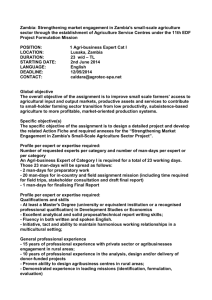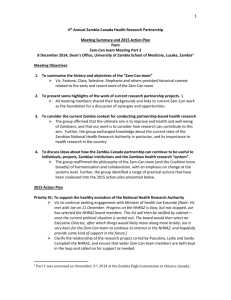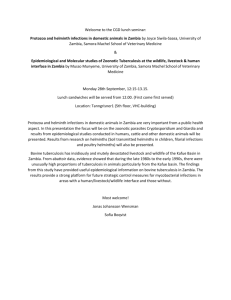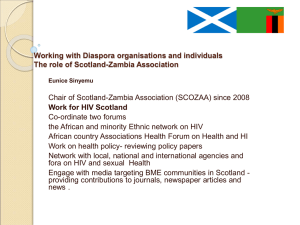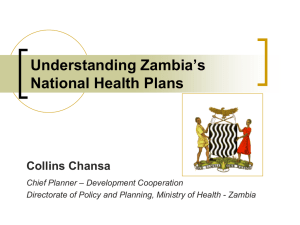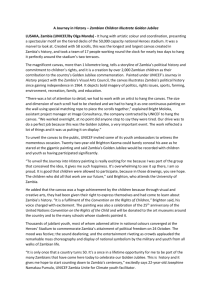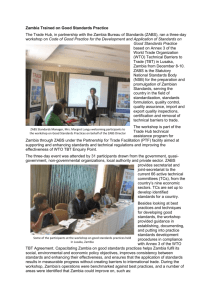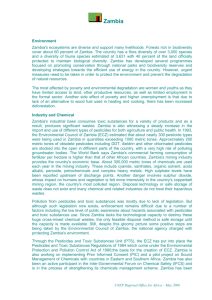Dr Peter Mwaba
advertisement
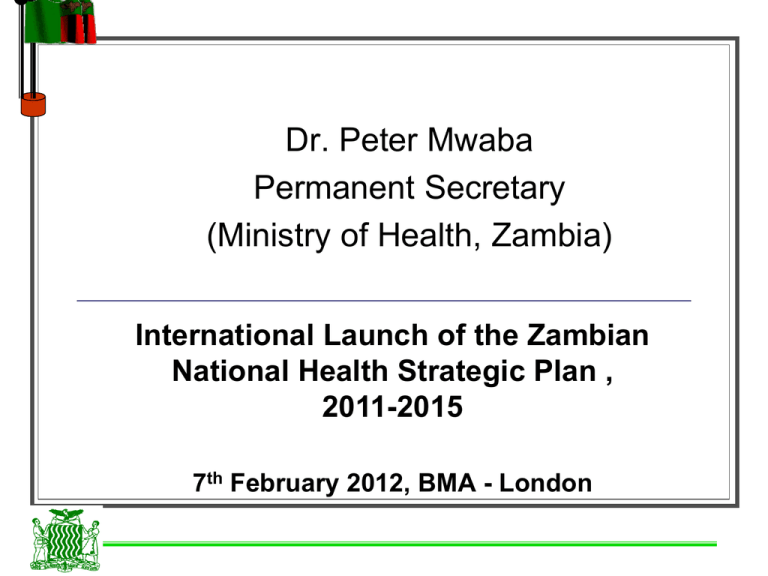
Dr. Peter Mwaba Permanent Secretary (Ministry of Health, Zambia) International Launch of the Zambian National Health Strategic Plan , 2011-2015 7th February 2012, BMA - London Background to NHSP 2011-2015 The NHSP 2011-2015 is the 5th National Health Strategic Plan for the Health Sector in Zambia The NHSP was drafted in the context of the Country’s Sixth National Development Plan 2011-2015 (it is a chapter) The NHSP process started in 2010 and was a collaborative effort between the Government, Cooperating Partners, The Civil Society and the Private Sector The NHSP 2011-2015 was officially launched on 26th January 2012 by the Minister of Health Thematic Themes of NHSP 2011-2015 Service Delivery (District Health Services & Hospital Referral Services) Human Resources for Health Infrastructure, Equipment and Commodities Health Management Information System Health Care Financing Leadership and Governance QUALITY OF CARE EMPHASIS Focus on three Cs of Quality of Care: Clean Caring Competent Legal Framework National Health Services Act of 1995 was repealed Thus the National Health Policy and a New Health Services Act is underway The PPP Policy and the PPP Act is in place Through statutory Instrument 27, of 2007 Government has declared the health sector as a priority sector. Organization of the Health System in Zambia (1) Institutional Set up National Level: MoH HQs in Lusaka is responsible for overall coordiantion and management of the health sector Provincial level: Provincial Health Offices (PHOs) are responsible for cordinating health service delivery in their respective provinces District Level: District Health Offices (DHOs) are responsible for cordinating health service delivery at district level Community Level: Neighbourhood Health Committees (NHCs) have been established to facilitate linkages between the communities and the health system Categories Health Facility Categories Community level: Health Posts and Health Centre District Level: Level 1 hospitals Provincial Level: Level 2 General Hospitals National Level: Level 3 Tertiary Hospitals COLLABORATIVE OPPORTUNITIES AND AREAS OF SUPPORT IN THE HEALTH SECTOR IN ZAMBIA Establishment of Specialist Hospitals (Centres of Excellence) The non existence of state of the art specialist health facilities has eroded Zambia’s revenue in form of foreign exchange Many Zambians continue to seek treatment in South Africa, India and other parts of the World at great cost to Government. The rise in non-communicable diseases that require specialist treatment and Hi-tech medical equipment, inadequacy of infrastructure development to meet the demand and the state of medical equipment in some public health institutions The slow pace of the existing private health sector to grow and fill the gap in the provision of specialised treatment Specific Speciality Areas Cardiology Radiotherapy Neurology Urology Traumatology Nephrology & Dialysis Diabetology Dermatology Physiotherapy Key hole surgery Stem Cell Therapy Other surgical interventions Establishment of Hi-Tech Diagnostic Centres. Government recognises that most referrals to foreign health facilities are originating from inadequate diagnostic and laboratory equipment to enable our medical personnel perform effectively. The country has three CT Scan machines and one MRI machine. The establishment of Modern Hi-Tech diagnostic centres is expected to provide a new face in the delivery of health services in Zambia and mostly attract patients from neighbouring countries, as away of creating revenue to the Zambian economy. The Ministry Health has plans to set up at least three modern diagnostic centres in Livingstone, Lusaka and Ndola. Education (Training of Health Personnel) Zambian medical doctors, nurses and paramedics are highly sought around the world hence the brain drain which has worsened the human resource crisis in the health sector in Zambia. A continued production of this highly sought cadre for the health sector in Zambia but also become a source of income through well arranged agreements with user countries. Government has prioritised scaling up of production of human resources e.g. a construction of a highproduction national training centre will start in 2012 Education (Training of health Personnel) Currently Zambia has only two public medical schools (one just started in 2011) and over 20 public nursing schools. The private sector is slowly responding - two medical schools have been set up by the private sector in the recent past Telemedicine In the face of a problem of inadequacy of human resources for health, the establishment of an efficient Telemedicine system in Zambia will provide an opportunity for many Zambians to access specialist services even in their far remote areas. As far as 2003, the Ministry of Health has been studying ways of establishing telemedicine on a pilot basis at the University Teaching Hospital (UTH). A joint effort by the private sector with Government will make this project possible and Government should buy into these specialised IT services for health service delivery. Pharmaceuticals There are only about 7 Manufacturing Companies in Zambia. Most of these Manufacturing Companies are engaged in the Manufacturing of Basic Pharmaceutical Formulations (Medicines). The Majority of Drugs required under the Essential Drug List is still being imported. Manufacture of pharmaceutical products is an area of collaboration and support Overall There are many opportunities in the health sector for partners and investors to participate The recently launched NHSP 2011-2015 provides a framework for any support, collaboration and investment in the health sector in Zambia There are other more specific documents that go into detail in specific programmes such as Human Resources, TB, Malaria, HIV/AIDS, etc The Plan is not cast in concrete but is a rolling plan with annual budgets and action plans END

